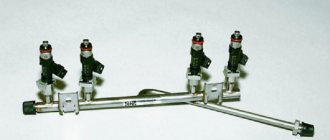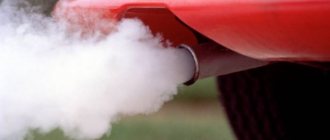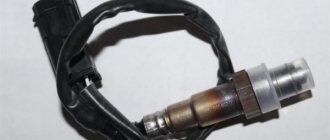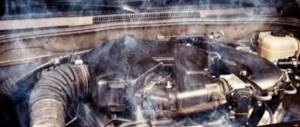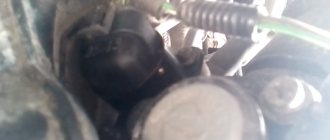For some reason, many car owners confuse concepts such as compression and compression ratio. However, despite their similarity, they are not one and the same. This is approximately the same as the angle of the closed state of the contacts and the ignition timing angle. It is enough to note that the compression ratio is a geometric value, expressed in absolute units (in other words, it is simply data that is not measured in any units), they are virtually unchanged for engines of the same model, if they have not been modified, but are in the standard configuration . Compression, in turn, is measured in pressure units (bar, MPa, atmospheres), its readings are very dependent on the measurement method and the technical condition of the car. At the moment we will tell you about what the compression of the VAZ 2110 engine is.
Compression is a physical quantity that determines the pressure that is created in the cylinder at the end of the compression stroke. It is measured in kg/cm2 or atmospheres; less often you can find measurements in kilopascals, bars and other units. As wear occurs, compression can vary greatly. It may depend on the compression ratio (good engine compression can be considered to be approximately the calculated value by multiplying the compression ratio by 1.5 atm - this is due to the effect of adiabatic compression). As a result, the corresponding compression values for a standard VAZ 2110 engine will be approximately 7-9 atmospheres. (If the engine is forced, the compression may change to 11-13 atm.).
The meaning of compression is the technical condition of the engine and the entire machine as a whole, along with oil pressure. The higher the compression level, the fewer gases will break into the engine crankcase and, as follows, more gases will do useful work, and at the same time the power will also increase. Oil consumption, throttle response, engine stability, engine start-up speed, fuel consumption will all depend on the compression level. In addition to all this, the compression value can be affected by the state of the electrical equipment (battery, starter, connecting wires) when measuring it.
When compression drops in any of the VAZ 2110 cylinders (maybe this happens in all cylinders at once) or compression levels are different in all cylinders, the engine will need to be repaired. Often the main reason for a drop in compression is worn out piston rings, for example, after overheating. In second place are valves. Then a breakdown of the cylinder head gasket. There may also be exotic conditions, such as a piston pin that has come out, or a burnt piston that has “milled” the liner. In order to find the cause of the drop and imbalance of compression, oil is poured into the cylinder, after which the compression is determined again. If at the same time it increases significantly, then the rings are almost always to blame. If not, the problem is most likely in the valves or head.
The main significant problems that low compression causes are a drop in power, a decrease in top speed, deterioration in acceleration dynamics, and an increase in the amount of fuel and oil absorbed - sometimes this is very noticeable.
To measure the compression of a VAZ 2110 you need to use a special device - a compression meter, which looks like an ordinary pressure gauge, with which the tire pressure will be measured. This device has a special adapter that needs to be screwed into the candles, or simply pressed tightly against the hole with a rubber ring. The adapter has a nipple or spool that allows you to save the instrument readings for comfortable reading. Such compression meters can be purchased at any auto market.
Compression is often determined in two ways: advanced - with closed valves in the carburetor, very ordinary - with open valves. To obtain clearer results, professional mechanics measure compression using 2 proposed methods. At the same time, they do not even unscrew the spark plugs in other cylinders, taking measurements on a cool engine, with the carburetor valves open or closed. Any of the methods gives its results and helps to find flaws more accurately.
If the damper is one hundred percent closed, a small amount of air enters the cylinders. The maximum pressure in the cylinder will not be huge, about 7-8 atm, because the pressure in the manifold is also not high (1 atm with a 100% open throttle, instead - 0.5-0.6 atm). When the damper is closed, leaks are small, and there are practically no pressure drops. The pressure in the cylinder is very sensitive to leaks - even for a minor reason, the pressure can drop a couple of times.
When the throttle is one hundred percent open, this will not happen. Significantly more air will enter the cylinder, which will lead to increased compression, while leaks will be significantly less than the air supply. As a result, even with severe deficiencies, the compression may not drop to a low level (for example, the low compression of a VAZ 2110 engine will be 9-10 atmospheres).
Based on the design features of the various compression measurement options, we will give some advice on their use.
With the throttle one hundred percent open, compression measurements allow you to find:
- scoring (severe damage) to the cylinder surface;
- burnout or deformation of valves;
- coking (hanging) of the rings in the piston grooves;
- burnouts and piston failures.
With the throttle closed one hundred percent, compression measurements allow you to find:
- valve hanging (in designs with hydraulic tappets - shortcomings in the camshaft cam profile;
- unsatisfactory fit of the seat to the valve.
Thus, for cars without hydraulic compensators, such as the VAZ 2110, it makes sense to determine the compression with the dampers open.
Recently I was asked a question on my blog - why can there be different compression in the engine cylinders? The question, I’ll tell you the truth, is an interesting one, I personally asked myself this a long time ago when I was rebuilding the engine, but now it’s becoming less and less common because I drive more or less new cars. However, for those who have a mileage of 150 – 200,000 kilometers, this is dedicated to...
So why does this happen - when in one the pressure is much less than in the others? There may be several reasons for this, all from my experience, but you almost always need to remove the cylinder head:
1) Gasket is broken
. This happens very often when the gasket between the block and the block head breaks - we just replace it.
2) Head not tightened
. This is a continuation of the first reason - if the head is not tightened correctly, the gasket can also leak pressure.
These are the simplest reasons, but they are the most common - for example, this often happened on my new purchased VAZs, in particular on a VAZ 2114 and a friend on a VAZ 2110. So, first of all, we go there, on new "our brands" - the problem This will be 80%. Then there are more complicated problems.
1) Leaking o-rings
. This happens due to wear and tear, or because they are broken. However, if the pressure has dropped in one of the cylinders, then it is most likely broken. The repair is complicated, you need to disassemble the block itself to remove the pistons.
2) The rings are coked
. I decided to put it in a separate section - low-quality motor oil can cause the rings to become coked.
The oil simply burns at the points of contact and seals the rings in one place - although this is not correct, the rings do not move along their grooves, and only one side is machined, which leads to rapid wear - although in this way the pressure will drop in all 4 cylinders. Because oil lubricates all 4 pieces.
3) Block wall wear
. This is rare - but it does happen, that is, the ring has nothing to do with it, but it is the walls that they rub against that suffer. Most likely, this is low-quality material.
4) . When overheated, the tightness of the rings and walls of the block is lost, they begin to leak both pressure and engine oil. An indirect sign - during work.
5) Burnt out - the piston itself broke
. In such cases, compression may simply drop to “zero”.
Sometimes the piston itself burns out, it can be a small “burnout” on the side, or a very large one – for example, in the middle. It also happens that the piston breaks, for example from meeting a valve when the timing belt breaks - again we lose atmosphere.
6) valves
. There are many reasons for this. This is also an incorrect adjustment. And it happens that a valve burns out - only one burns, so the compression will vary in exactly one cylinder. It can also break if the timing belt breaks.
These are the main reasons why the values will differ in exactly one pot out of all four.
Repair
As I wrote above, it’s really difficult to make repairs yourself. Unless, of course, you have a blown gasket, it’s possible to repair it, but again, it’s not so easy. How to replace a short video.
Diagnostics are carried out with the cylinder head removed - here the malfunction can be determined 100%. You are unlikely to do it yourself; contact specialists at a service station, or people who understand.
You can diagnose the parts of the power unit without disassembling it. For correct diagnosis, you need to know what compression should be in 2110. The article contains information on methods for measuring compression and detailed instructions with a video test of a 16-valve engine.
[Hide]
Why is verification needed?
After long-term operation, the 16-valve VAZ 2110 engine begins to operate unevenly, smoke, and fuel and oil consumption increases. The cause of such problems may be significant wear of the connecting rod and piston group. To find out, it is not necessary to completely disassemble the engine; it is enough to measure the pressure in its cylinders depending on what compression it is to draw conclusions about the serviceability of the components.
Compression is the pressure in the cylinders of the air-fuel mixture that is created at the end of the compression stroke. If the compression is too high, there is a high concentration of the air-fuel mixture, as a result it quickly ignites and an explosion occurs. This has a destructive effect on the parts of the VAZ 2110 engine with 16 valves.
With low compression, engine power decreases, engine speed deteriorates, it does not reach maximum speed, and fuel and lubricant consumption increases. The air-fuel mixture ignites slowly, which leads to overheating of the engine. If there are different pressures in the cylinders, then the mixture will ignite earlier in one and later in the other. Under such conditions, the engine will operate unevenly, the consistency in the operation of the shafts and pistons will disappear, which increases their wear.
The pressure in the cylinders may decrease for the following reasons:
- valve or piston burnout;
- wear of the connecting rod and piston group;
- burnout of the cylinder head gasket;
- cracks in the exhaust valve plate;
- destruction of the valve seat.
What is the standard compression for a VAZ 2110 with 16 valves can be calculated using the following formula:
Compression = compression ratio * K factor
The compression ratio is indicated in the vehicle's owner's manual and is different for each model. The K coefficient depends on the type of engine: for a gasoline engine it is 1.2, for a diesel engine it is 1.8. Experienced drivers do not need calculations, since they know from their experience what compression should be on their car.
You should regularly measure the compression in the cylinders in order to diagnose and eliminate problems in a timely manner without bringing the engine to overhaul. Measurements are taken with the carburetor flaps open and closed.
An open damper makes it possible to detect the following problems:
- scoring and mechanical damage to the surface of the cylinders;
- burnouts and deformation of valves;
- malfunctions and burnouts of valves;
- coking and sticking of piston rings.
When the damper is closed, you can determine:
- Are the valves stuck?
- if a hydraulic tappet is used, defects in the camshaft cam profile are determined;
- contact with the valve seat.
What should the compression be on a VAZ 2109
If blueish smoke is coming out of the exhaust pipe, it is likely that the piston rings in the engine are worn out, but to be sure, you need to measure the compression in the engine cylinders. This article will give clear instructions for checking the compression of the VAZ 2109. For this you do not need expensive equipment, only a compressor is useful.
First you need to start the engine and warm it up to an operating temperature of 80-90 degrees. Also, first of all you need to check the valve clearances, they should be the same and if they are not, you need to adjust them. Then, using a special wrench, you need to remove the spark plugs, of which there are only 4 pieces, after which you need to open the throttle and choke. We take the compressor and put it on the end in the spark plug socket. Then you need to use a starter. The spark plugs are removed, so the engine will not be able to start and a characteristic sound will be heard.
READ How to Close the Heater Damper on a VAZ 2114
It is difficult to cope with such work alone, so you have to seek help from an assistant. When one turns the ignition key, the other looks at the sensor at the same time. The device must be held firmly by hand as it may fly sideways under high pressure. Stop rotating the crankshaft when the sensor is running at maximum speed. To get the correct readings, you must first ensure that the crankshaft is spinning between 180 and 350 rpm.
During the test, the car battery must be fully charged. If the power supply uses a different cell, you will need to increase the voltage for a while. A high device score should
be written down on a piece of paper and then the device must be reset to zero.
A similar operation must be done with other cylinders. Keep in mind that the minimum compression ratio in the car's cylinders must be 10 kg/sq.m. See, and the difference between pages should not exceed 1 kg/sq. See If one cylinder has a little more compression than the other, the problem is that the valves are depressurizing from the seats, the compression rings are worn out, or the cylinder block gasket is worn out. If the measurements were very low for all rings, then the piston rings are worn.
To accurately check for low compression, you need to pour 20-25 cubic meters into a separate cylinder directly into the spark plug hole. Refer to the engine oil, then check the compression level again. Did the sensor show the same numbers as during the previous measurement? Thus, the valves release pressure from the seats or the cylinder block gasket is worn out. If the compression is high and the oil level rises, then the whole issue is the wear of the piston rings. The possible cause of low compression can be measured in another way.
The piston should be fixed at the top of the compression stroke, and the air pressure should be 2-3 kg/sq.m.
Air is blown into the spark plug spot. There is no need to rotate the engine crankshaft, and accordingly we put the gear shift lever in lower gear. When air leaves the carburetor, the intake valve is reduced and the exhaust valve is reduced by pressure through the muffler.
When the cylinder head gasket wears out, small bubbles will form in the radiator or other valve and a hissing noise will be heard. Taken from https://www.Mylada.Ru.
The first signs of engine problems are: poor dynamics, sluggish response to the accelerator pedal, lack of high torque. Reasons why the engine may move
The first signs of engine problems are: poor dynamics, sluggish response to the accelerator pedal, lack of high torque. Reasons why the engine may move
Engine compression indicates the condition of the engine, its life, power and thrust. This procedure should be performed every 20-30 thousand km
If there is bluish smoke coming out of the exhaust pipe, it is likely that the piston rings are worn out in the engine, but to be sure this is ultimately necessary
Engine compression indicates the condition of the engine, its life, power and thrust. This procedure should be performed every 20-30 thousand km
We do a check for a 16-valve car
To carry out a compression test on a 16-valve VAZ 2110 engine, it is better to invite an assistant and prepare the following tools:
When choosing a device, you should pay attention to its limit switch, which is used to connect to the engine. It can be threaded or rubber. It is better to choose one with threads, this will make the work easier.
Many VAZ-2110 owners wonder why their cars have different compression? Typically, compression is injected as the piston moves from the bottom to the top. In this case, a certain pressure is created in the cylinder. Good compression can only happen if all gaskets, pistons, rings or valves are in good condition. It is because of these elements that the air in the system is compressed.
Checking engine compression on a VAZ 2109
If blue smoke comes out of the exhaust pipe of a VAZ 2109, this is most likely due to wear on the piston rings, but for this it is necessary to measure the compression in the engine cylinders. We will check the engine compression on a VAZ 2109. For this you do not need special equipment, only a compressor is useful.
So, we start the VAZ 2109 and warm it up to operating temperature, which is about 80-90 degrees. You also need to check the valve clearances, they should be the same, so if they are not, then you will need to adjust them. Next, unscrew the spark plugs using a special key, there are 4 of them on the VAZ 2109, then open the throttle and air damper. Take the compressor and insert its end into the spark plug slot. Now you need to use the starter. Since the spark plugs are removed, the car will not start, there will only be a characteristic sound. She won't be able to do this kind of work alone, so a helper will be helpful. While one person turns the ignition switch, another monitors the compressor sensor readings. Attention, the measuring device must be held by hand, otherwise it may fly out under air pressure. Stop turning the engine when the pressure stops increasing. To achieve correct readings, it is necessary to ensure that the crankshaft rotates in the range from 180 to 350 rpm. During the inspection, make sure the car battery is charged.
If you connect another power source to the starter terminals, you may overvoltage for a while. Write down the highest indicator value on a piece of paper, and then reset the arrow to zero. The same operation must be done with the remaining three cylinders. Remember that the minimum permissible compression ratio in the cylinders must be at least 10 kg/sq.m. See, and the difference between the cylinders should not exceed 1 kg / sq. See: If one cylinder has less compression than the other, the problem is a leaky valve seat, worn compression rings, or a damaged cylinder block gasket. If measurements show a low level of compression in all rings, then this is wear on the piston rings. To more accurately determine low compression in one cylinder, you will need to pour 20-25 cc directly into the spark plug hole. See the engine oil and measure the compression ratio again. Does the sensor show the same numbers? Thus, the valves release pressure from the seats or the cylinder block gasket is worn out. At high compression, when the oil level rises, this is wear on the piston rings. The cause of low compression can be checked in another way. It is necessary to fix the piston at the top point of the compression stroke and pass air under a pressure of 2-3 kg/sq.m. See This air is forced through the spark plug hole. There is no need to allow the crankshaft to rotate the engine, so set the gearbox to a lower gear. If air passes through the carburetor, the intake valve is reduced, if the exhaust valve is reduced through the muffler. If the cylinder head gasket is worn, air bubbles will form in the radiator or other valve and a hissing sound will occur.
Source
Due to the fact that more than 4 million units of VAZ 2106 models were produced, there are still quite a lot of them on our roads. Accordingly, the renovation of the legendary “classics” is still relevant. For example, the question of how much compression a running Six engine should maintain.
READ Installation of 2 Din Radios in VAZ 2110
Normal compression on a VAZ-2110
Typically, compression is checked using a special device. It is recommended to do this regularly.
This helps determine the degree of wear of the motor and rings, as well as the piston itself. Normal cylinder pressure on a VAZ-2110 with 8 valves should be from 10 to 12 atmospheres
.
Normal compression in the cylinder.
It is also worth noting that sometimes the pressure in different cylinders may differ
.
If it is 0.5-0.7 atmospheres
, then this phenomenon is normal and should not cause concern.
Abnormal compression
This happens when there are more or less atmospheres in the cylinder than in others.
Such an engine will not be able to operate normally. He absolutely needs to carry out repairs.
Causes
Burnout of the gasket between the block and the head is a fairly common defect.
There can be many reasons why there may be a difference in compression. Experts highlight the main ones. This:
- The head and block gaskets are burnt out. It just needs to be changed.
- The head is not tightened. The gasket may burn out here.
- The rings don't hold. The reason here is the wear of the rings or their breakage. If the pressure drops in one cylinder, this often indicates a broken ring. This will require piston repair.
- Coked rings. They will need to be cleaned.
- Block wear. Happens rarely.
- Motor overheating.
- The piston is broken or burnt out. There is no compression at all.
- Valves not adjusted.
Video: What Compression Should Be on a VAZ 2110
If you have regular motor oil on hand, it is easy to check the compression reduction on the VAZ-2109 by following this guide:
- Add 10cc of oil to the cylinder and measure the pressure again.
- If the performance of the flow meter has increased, then the malfunction causes the appearance of rings and wear of the cylinder-piston unit.
- If the compressor values remain at the same level, this means that the valve is burnt out or the gasket adjacent to the head of the device is damaged.
Repair
As can be seen from the above, there are many reasons for different compression in the cylinders. In this case, it is not always possible to carry out repairs yourself, especially if you do not have the skills. In this case, it is recommended to contact specialists at a service station.
Traditional methods of increasing compression
It is noted that the methods described below cannot be a 100% guarantee that compression in the cylinders will increase.
- Buy a quality valve cleaning fluid and pour it into the oil.
- Pour this liquid into the cylinders overnight.
conclusions
Knowing these points, you should not worry about the difference in compression in different cylinders on a VAZ-2110, if it is small. When the standard exceeds acceptable values, repairs will be required.
.
The pressure created in the engine cylinders is otherwise called compression. If its level in the cylinder is too low, a large volume is occupied by the fuel-air mixture, which has a low concentration, which leads to slow ignition. At the same time, heat transfer increases and the engine overheats. If the compression level is very high, rapid ignition of the fuel-air mixture occurs, due to the high concentration, detonation or explosion of the mixture occurs. At this time, the engine experiences increased pressure, which has a destructive effect on its parts. There are situations when the compression in the cylinders on a VAZ 2110 is different. In this case, ignition occurs faster in one cylinder, slower in the other, and the engine begins to operate unevenly. An imbalance is created in the operation of the pistons and shafts, which has a negative impact on their condition.
Compression in the cylinders of a VAZ 2110, how to check?
Compression measurement in VAZ 2110 cylinders
The pressure created in the engine cylinders is otherwise called compression. If its level in the cylinder is too low, a large volume is occupied by the fuel-air mixture, which has a low concentration, which leads to slow ignition. At the same time, heat transfer increases and the engine overheats. If the compression level is very high, rapid ignition of the fuel-air mixture occurs, due to the high concentration, detonation or explosion of the mixture occurs. At this time, the engine experiences increased pressure, which has a destructive effect on its parts. There are situations when the compression in the cylinders on a VAZ 2110 is different. In this case, ignition occurs faster in one cylinder, slower in the other, and the engine begins to operate unevenly. An imbalance is created in the operation of the pistons and shafts, which has a negative impact on their condition.
How to control compression in the cylinders of a VAZ 2110
Each method helps to more accurately determine node defects
.Compression is most often measured with the throttles in the carburetor closed and open. When the valve is fully open after measuring compression, the following defects can be detected:
- The presence of scoring or serious damage to the cylinder surface.
- No burnouts or valve deformations.
- Rings stuck or coked in the piston grooves.
- Broken or burnt pistons.
With the throttle closed, after measuring the compression, the following is determined:
- Is there a stuck valve? If the design has a hydraulic tappet, the presence of defects in the camshaft cam profile is determined.
- Seat valve fit.
The compression of the cylinders of a VAZ 2110, a car without a hydraulic compensator (see), is measured with the dampers open.
Why check
It is recommended to check the compression on the VAZ 2110 regularly to prevent possible malfunctions and problems with the engine.
Measurements are taken with the throttle valve open and closed. Each test option gives its own results and data on the condition of the engine.
Checking with the valve open allows you to determine:
- Problems and damage on cylinder surfaces;
- Deformation, burnout of valves;
- Sticking or coking of piston rings.
Article on the topic: What to do if the VAZ 2110 does not start
If you check the compression with the throttle closed, you can find out:
- Are the valves stuck?
- Is there a tight fit to the valve seat?
- If a hydraulic tappet is present, the presence of defects in the camshaft cam profile is determined.
Methods
There are two main ways in which you can check the compression readings in the engine.
| Way | Peculiarities |
| Using measuring instruments | Effective, gives the most accurate results. But it requires special measuring instruments - a pressure gauge or compression gauge. Applicable in 90% of cases |
| Manual verification method | Difficult to perform because it requires unscrewing the spark plug from each cylinder and cranking the crankshaft. A problematic cylinder can be determined by the effort that has to be applied when turning. Efficiency is not high |
Considering the possible results of the test, it is recommended to always check the compression only with measuring instruments and do this at least once every 3-4 months, as well as if there is a suspicion of unstable engine operation.
We take measurements

